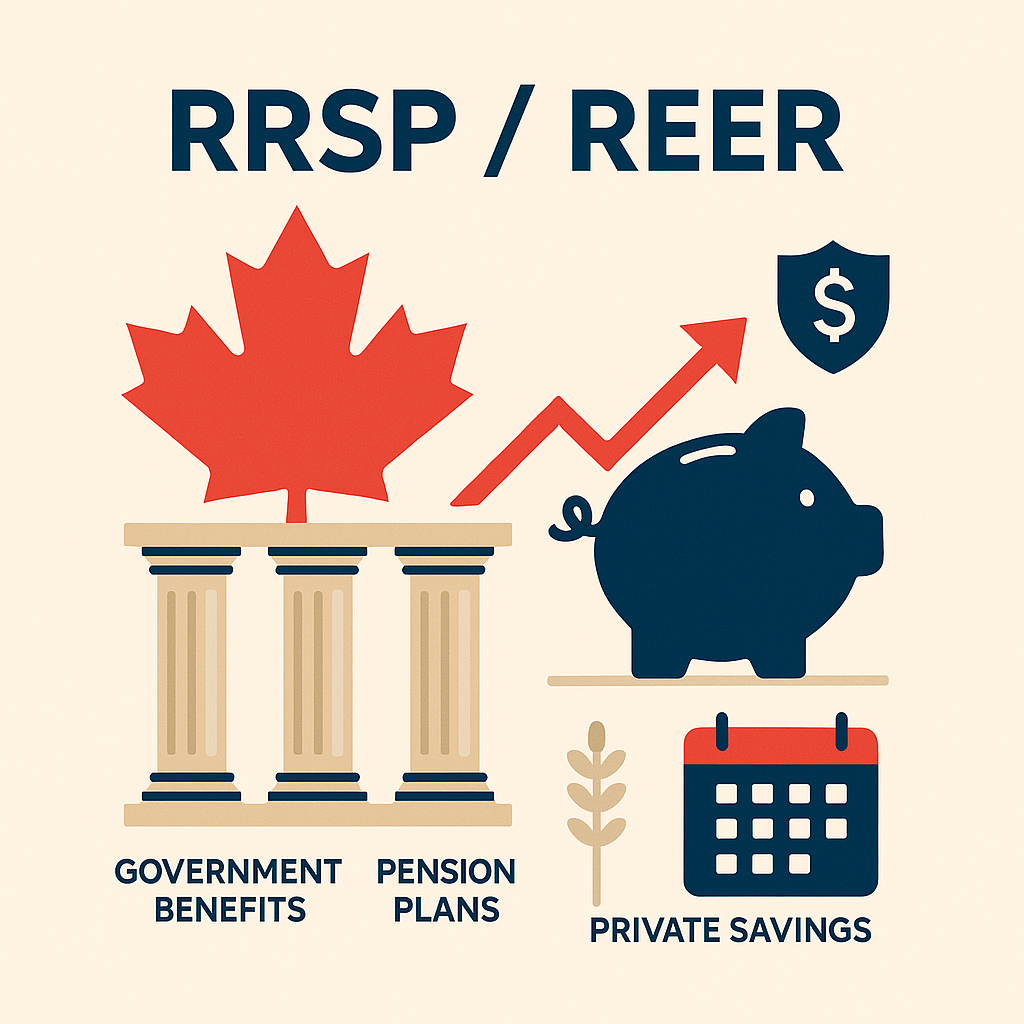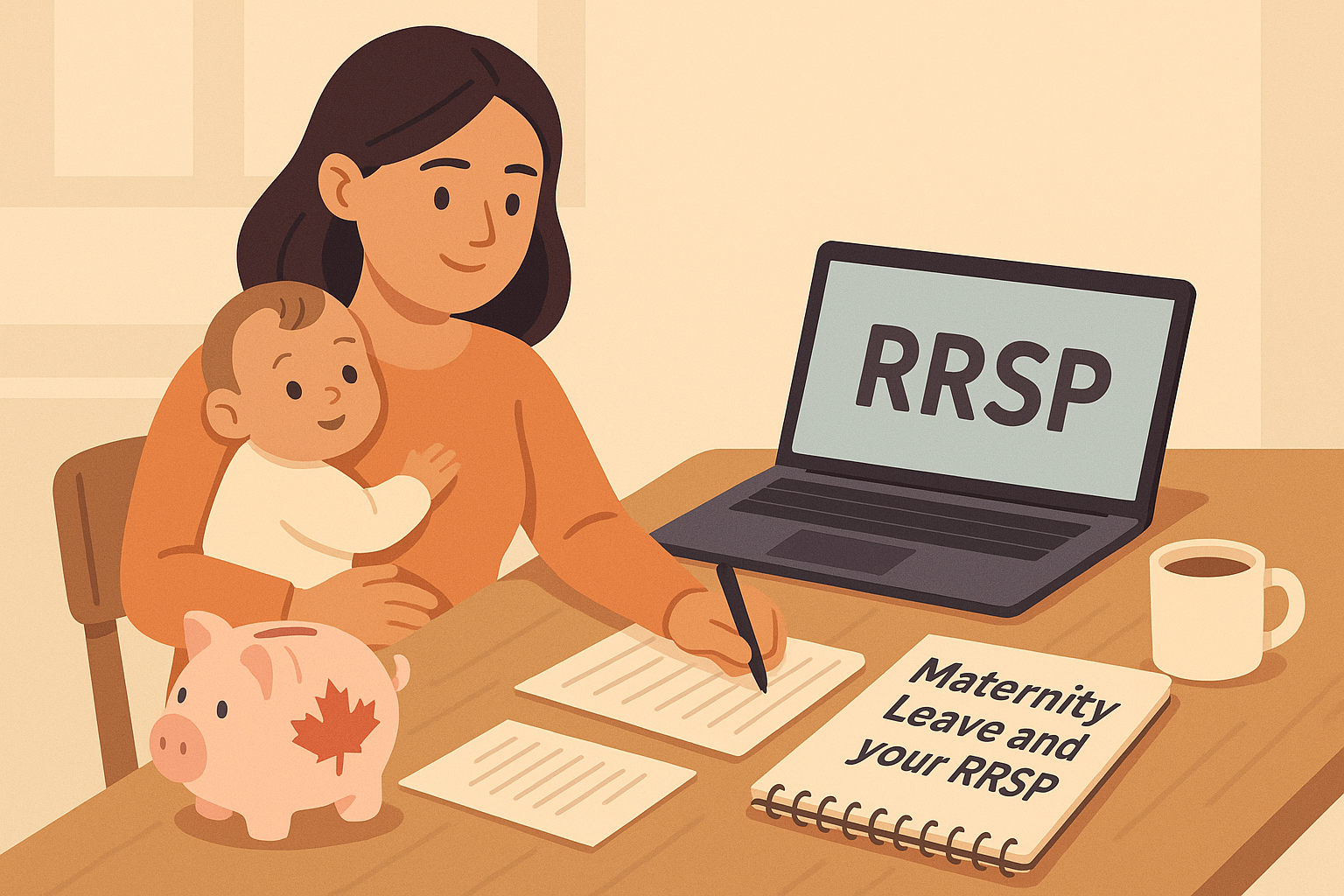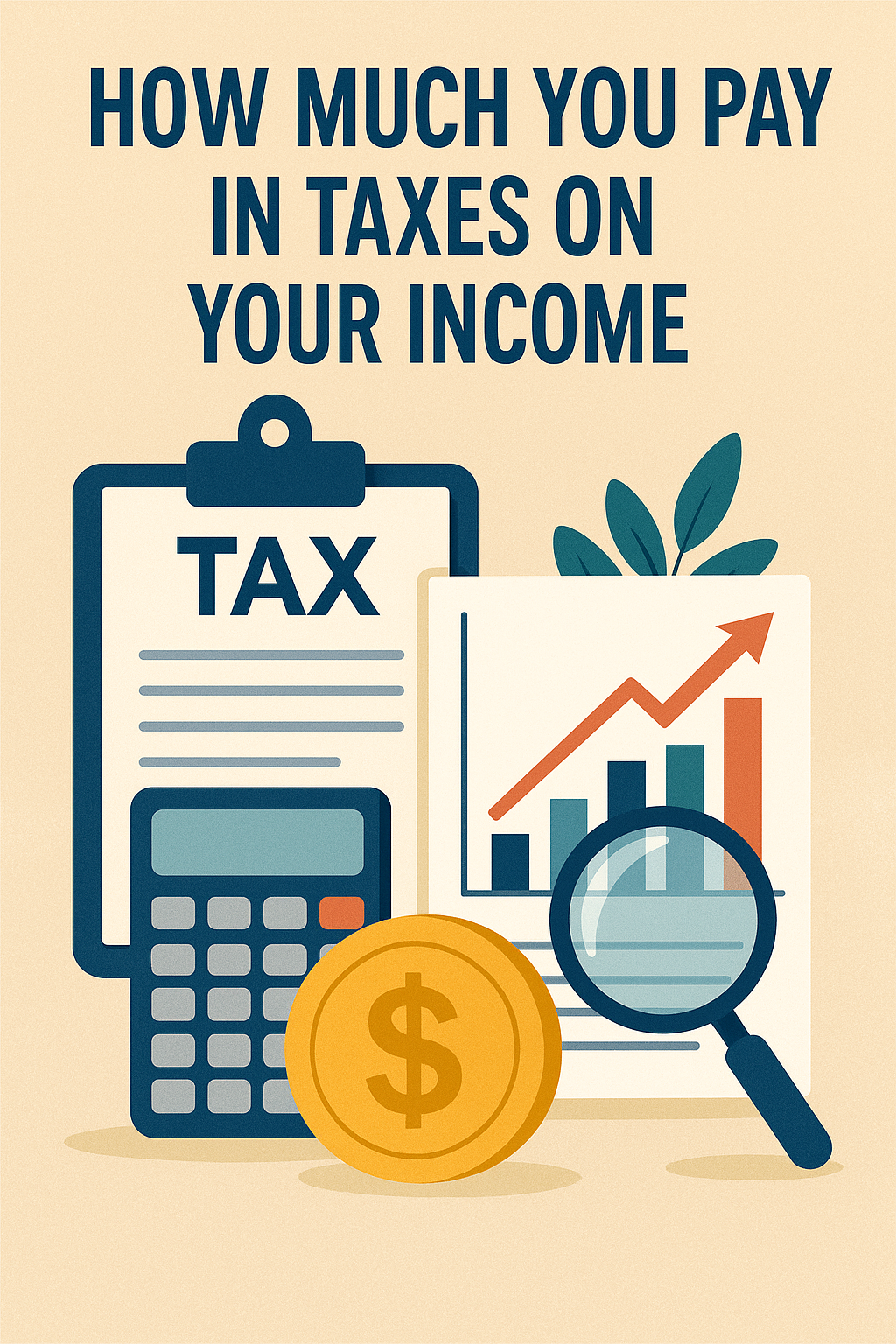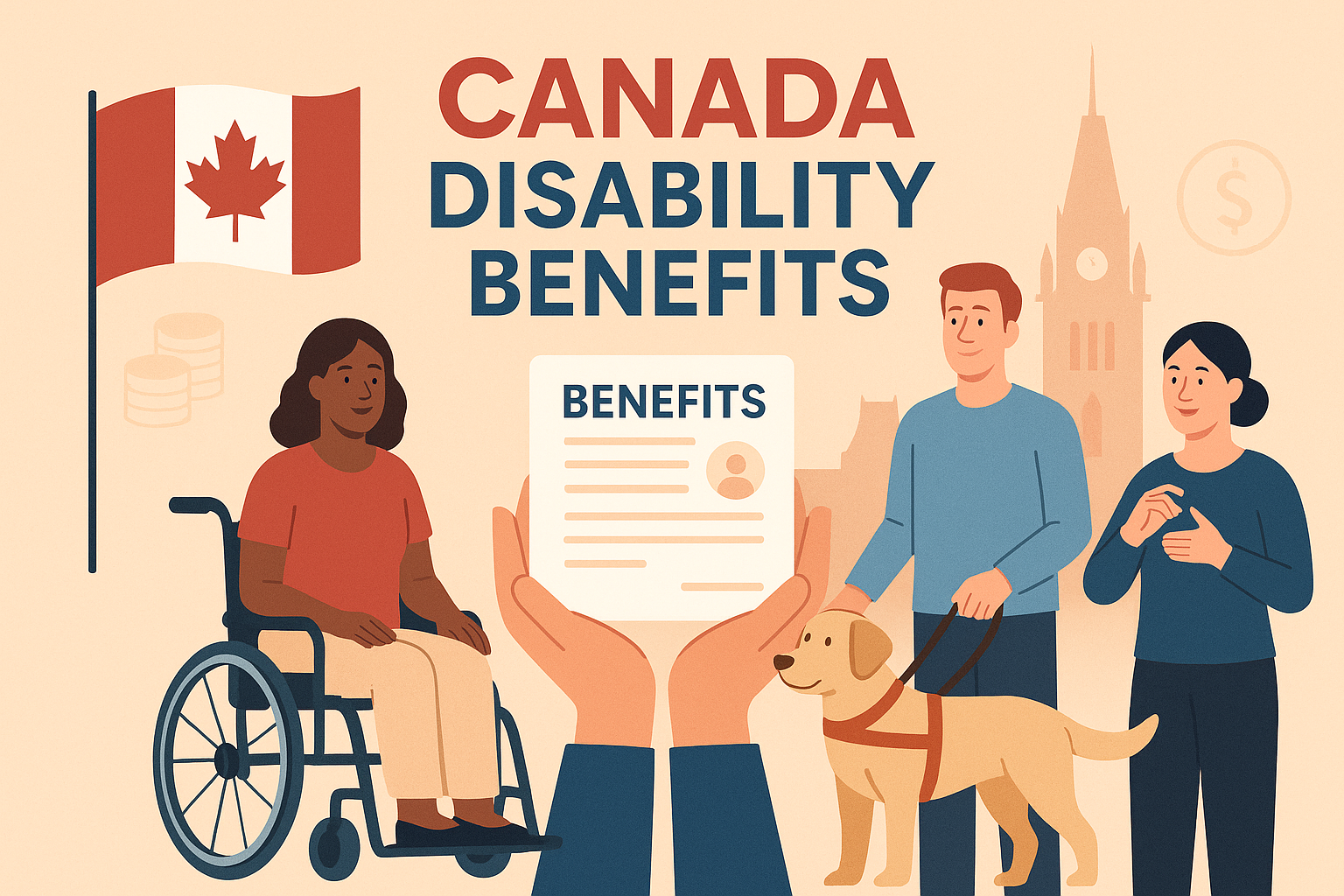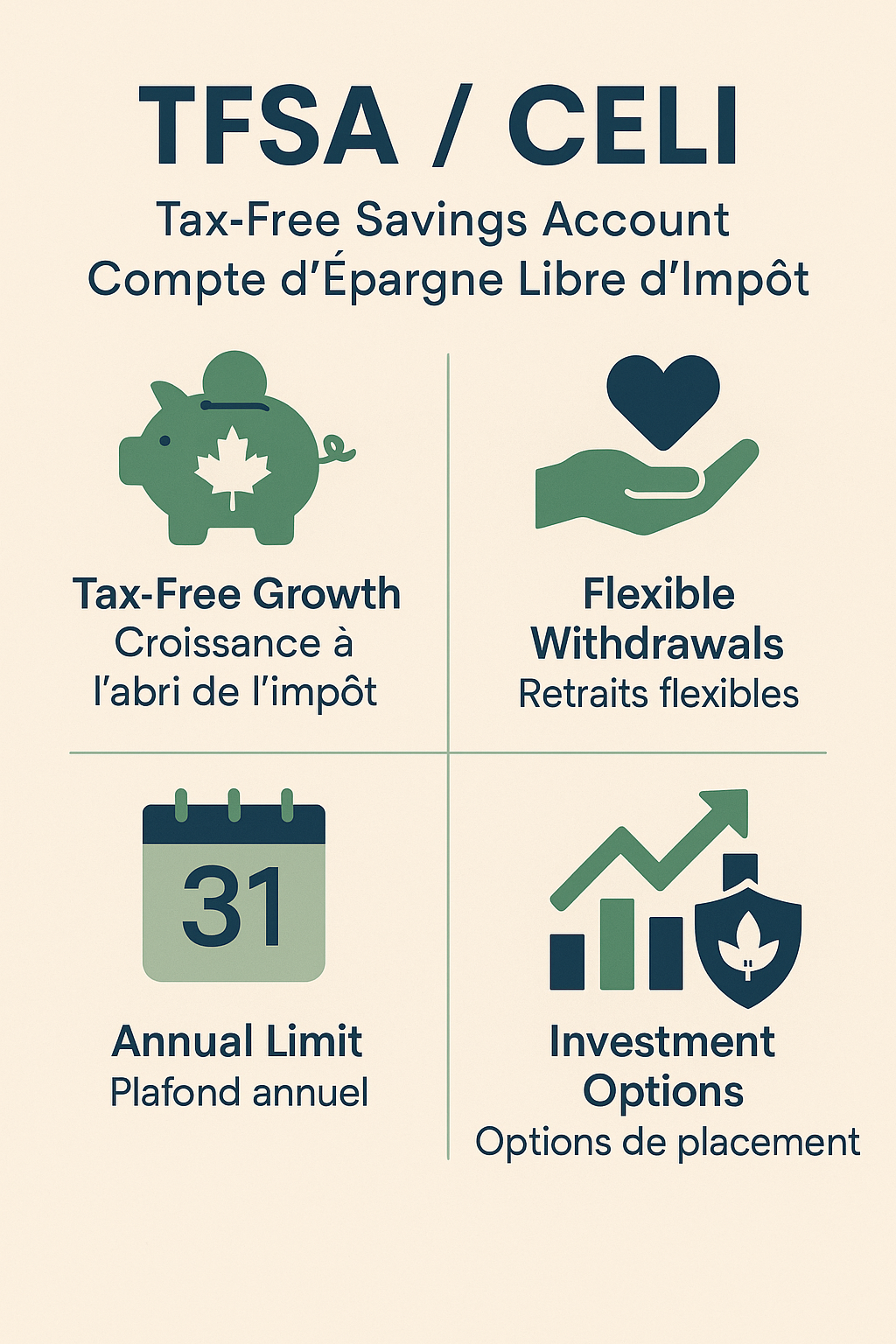The Registered Retirement Savings Plan (RRSP) is a government-registered account designed to encourage and help Canadians save for retirement by offering:
- Tax-deductible contributions: Amounts you contribute in a given year reduce your taxable income for that tax year.
- Tax-deferred growth: Investment earnings (interest, dividends, capital gains) inside the RRSP are not taxed while they remain in the plan; taxation occurs only upon withdrawal, presumably when you are in a lower tax bracket in retirement.
RRSPs fit within Canada’s “three pillars of retirement”: government benefits (Old Age Security, Guaranteed Income Supplement), public pensions (Canada Pension Plan / Quebec Pension Plan ), and private savings vehicles (RRSPs, TFSAs, employer pensions, non-registered accounts).
This guide updates key figures for 2025, and presents a clear roadmap to understand, utilize, and optimize your RRSP.
Disclaimer
While I try to ensure the accuracy of the information contained on this blog, I do not guarantee it. I’m not a licensed financial adviser nor a lawyer, so take this blog only as an educational resource and my personal thoughts and opinions. No liability is assumed for losses or disappointments due to the information provided. It is important that you always exercise your own judgement when making decisions that can impact your wallet, and your life!
I. Historical Context (Brief Overview)
- 1957 (Federal) / 1959 (Québec): Introduction of the RRSP, originally with contribution limits at the lesser of 10% of earned income or $2,500; unused room could not be carried forward.
- 1974: Introduction of spousal RRSP.
- 1978: Establishment of the Registered Retirement Income Fund (RRIF) framework for post-71 conversion.
- 1990 reforms:
- Unified tax-assisted retirement savings across pension types, introduced pension adjustments and carry-forward of unused RRSP room (initially up to 7 years, later indefinitely).
- Contribution limit set at the lesser of 18% of prior-year earned income or a fixed dollar amount (e.g., $11,500 in 1990), with gradual indexing thereafter.
Since 2011: RRSP limits indexed annually to average wage growth.
Understanding this evolution underscores that RRSP rules (contribution limits, carry-forward, pension adjustments) have been refined over decades to balance fairness across savers and encourage long-term retirement funding.
II. 2025 Contribution Limit and Room Calculation
1. Determining Your Exact Contribution Room
For the 2025 tax year, the maximum RRSP contribution limit is $32,490, reflecting 18% of 2024 earned income up to the indexed cap. Note that it is the Canada Revenue Agency (CRA) that announces the official annual maximum; you should verify it via CRA communications or Notice of Assessment.
To determine your exact contribution room, you could:
- Start with annual limit (18% of prior-year earned income, capped at $32,490 for 2025).
- Subtract Pension Adjustment (PA): If enrolled in a registered pension plan or deferred profit-sharing plan, the PA reported on your T4 reduces RRSP room.
- Add any carry-forward of unused room: Unused contribution room from previous years accumulates indefinitely.
- Result: The sum is your RRSP deduction limit shown on your latest Notice of Assessment or via CRA My Account.
2. Over-Contributions and Penalties
Up to $2,000 over your deduction limit may be contributed without penalty. Any excess beyond $2,000 triggers a 1% per month tax on the over-contributed amount until withdrawn or room becomes available.
III. Contribution Timing & Deadlines
RRSP contributions for a given tax year may be made in the first 60 days of the following calendar year. For the 2024 tax year, the deadline falls around March 3, 2025.
You can contribute up to December 31 of the year you turn 71. After that, new contributions cease, and the RRSP must be converted or collapsed.
Contribution Examples
To illustrate how RRSP contributions affect taxes, consider a simplified scenario using 2024 tax parameters (note: actual tax calculations vary by province, credits, and individual circumstances).
Let’s consider Alex who earned $75,000 in 2024, with no pension adjustment, and has $10,000 unused carry-forward room.
- Annual limit: 18% of $75,000 = $13,500 (below the $32,490 cap).
- Total room: $13,500 + $10,000 = $23,500.
- Contribution decision: Alex contributes $15,000 in early 2025 (for 2024 tax year).
- Tax effect:
- Taxable income for 2024 reduces from $75,000 to $60,000.
- Immediate tax savings depend on marginal rate; e.g., if marginal rate ~30%, potential tax reduction ~$4,500.
- Remaining unused room: $23,500 − $15,000 = $8,500 carried forward.
- Key takeaway: Contributing in higher-income years yields larger immediate tax savings; unused room allows flexibility to defer deductions to future years when beneficial.
Note: For more precise estimates, use a current-year tax calculator or consult a professional advisor.
IV. Tax-Deferred Growth & Investment Choices
Within an RRSP, you may hold a variety of qualified investments:
- Mutual funds, ETFs, stocks, bonds
- Guaranteed Investment Certificates (GICs)
- Other eligible securities as per financial institution offerings
Earnings compound faster because no tax is paid annually on interest, dividends, or capital gains inside the RRSP. Over decades, this compounding advantage can be substantial.
V. Strategic Withdrawal Options
Withdrawals from an RRSP are included in taxable income in the year of withdrawal; however, two major programs permit tax-free withdrawals if repaid over time:
- Home Buyers’ Plan (HBP): First-time homebuyers may withdraw up to $35,000 (per individual) to purchase/build a qualifying home. If both spouses qualify, each may withdraw up to $35,000. Over 15 years, beginning two years after withdrawal; minimum annual repayment is 1/15th of withdrawn amount. Missed repayments are added to taxable income.
- Lifelong Learning Plan (LLP): Students in qualifying full-time programs may withdraw up to $10,000 per year, to a maximum of $20,000 total. For couples, each may use separate room up to combined amounts. Over 10 years; minimum annual repayment is 1/10th of withdrawn amount. Missed repayments are included in taxable income.
- Withdrawals in Low-Income Years: If you have minimal other income, an RRSP withdrawal may incur little or no net tax once basic personal amounts (federal and provincial) are considered. Another strategy would be to plan occasional small withdrawals in early retirement or gap years to avoid heavy tax, but be mindful that withdrawn amounts reduce RRSP room permanently (except under HBP/LLP).
VI. After Age 71: Converting the RRSP
By December 31 of the year you turn 71, you must:
- Convert RRSP to Registered Retirement Income Fund (RRIF): Common choice, continues tax-deferred growth; minimum annual withdrawals apply based on age.
- Purchase an annuity: Guarantees a lifetime income stream, possibly indexed; involves trade-off of flexibility vs. predictability.
- Withdraw entire RRSP as cash: Generally inadvisable due to large immediate tax hit.
Selecting between RRIF vs. annuity depends on one’s risk tolerance, income needs, spouse’s situation, and estate planning considerations.
VII. Spousal RRSPs & Income Splitting
Spousal RRSP: Higher-earning spouse contributes to an RRSP in the lower-earning spouse’s name, using the contributor’s deduction room.
Benefit: Upon withdrawal in retirement, income may be taxed at the lower rate of the annuitant spouse, reducing the household’s overall tax burden.
Attribution rules: Withdrawals made within three years of contribution may be attributed back to the contributor for tax purposes; plan contributions and withdrawals timing accordingly.
Spousal RRSPs are particularly effective when there is a significant income gap between partners during contribution years.
VIII. Creditor Protection
In many jurisdictions, RRSP assets enjoy protection from creditors in case of bankruptcy or insolvency through the Federal Bankruptcy and Insolvency Act, subject to specified limits and provincial rules.
IX. Comparing RRSPs with Other Savings Vehicles
| Feature | RRSP | TFSA | Registered Pension Plan |
|---|---|---|---|
| Tax deduction on contribution | Yes | No | Yes |
| Tax on growth inside plan | Deferred | Tax-Free | Deferred |
| Withdrawal taxation | Taxable on withdrawal | Tax-free | Taxable on withdrawal |
| Annual government-set limit | $32,490 (2025) | $7,000 (2025) | N/A (plan-specific) |
| Age limit for contribution | Until end of year you turn 71 | None | Plan-dependent |
| Carry-forward room | Yes, indefinitely | Yes (unused TFSA room) | N/A |
| Withdrawal flexibility | Flexible, but taxable | Very flexible, tax-free | Restricted per plan rules |
| Income-splitting potential | Via spousal RRSP / RRIF | Limited | Depends on plan |
- When to prioritize RRSP: If you seek immediate tax deductions (especially in high-income years) and anticipate lower tax rates in retirement.
- When to prioritize TFSA: If you value withdrawal flexibility and expect similar or higher income in certain retirement years, or need short-to-medium term savings without tax consequences.
- Integration with employer pension: Understand how pension adjustments reduce RRSP room and plan contributions accordingly.
X. Practical Tips & Best Practices
- Check Your Room Before Contributing: Always verify RRSP deduction limit via CRA My Account or Notice of Assessment to avoid over-contribution penalties.
- Automate Contributions: Regular contributions (e.g., monthly) can average cost over market cycles and ensure full use of room.
- Align with Income Fluctuations: Contribute more in years of higher income; consider carrying forward deduction to a future higher-income year if contribution isn’t immediately needed.
- Coordinate with Spousal Planning: Use spousal RRSPs when appropriate to balance household tax burdens in retirement.
- Plan Withdrawals Carefully: Reserve withdrawals for HBP/LLP or genuinely low-income years; avoid eroding retirement capital prematurely.
- Review Investment Mix: Select investments within the RRSP aligned with time horizon, risk tolerance, and overall portfolio (e.g., equities for long-term growth, fixed income closer to retirement).
- Monitor Fees: Choose low-cost investment vehicles (e.g., low-fee ETFs or index funds) to maximize compounding.
- Seek Professional Advice When Needed: For complex situations (business owners, significant pension adjustments, cross-border issues), consult a qualified financial advisor or tax professional.
XI. Common FAQs
- How much can I contribute to my RRSP in 2025?
Up to 18% of your 2024 earned income, capped at $32,490, plus any unused carry-forward room. Check your exact deduction limit on your Notice of Assessment. - What happens if I over-contribute?
Up to $2,000 excess is penalty-free; beyond that, a 1% monthly tax applies on the excess until resolved. - Can I withdraw without penalty?
Only under Home Buyers’ Plan and Lifelong Learning Plan (subject to repayment schedules). Other withdrawals incur withholding tax and full inclusion in income. - Should I choose RRSP or TFSA?
Depends on your current vs. expected future tax rates, savings goals, and need for flexibility. Many use both in tandem. - What if I have an employer pension?
Pension adjustments reduce RRSP room; still consider RRSP if additional retirement savings are needed. - What’s the deadline for 2025 contributions? Typically around March 3, 2025.
Donate To Support This Blog
If you find this content helpful, please consider supporting Finance Faded with a small donation. As a solo author, I cover all costs—from hosting and domain fees to essential plugins and maintenance—out of pocket. Your contribution helps keep the site running and allows me to continue producing independent, high-quality financial insights. You can donate any amount by clicking on the “Buy Me a Coffee” button below. Thank you for your support!

